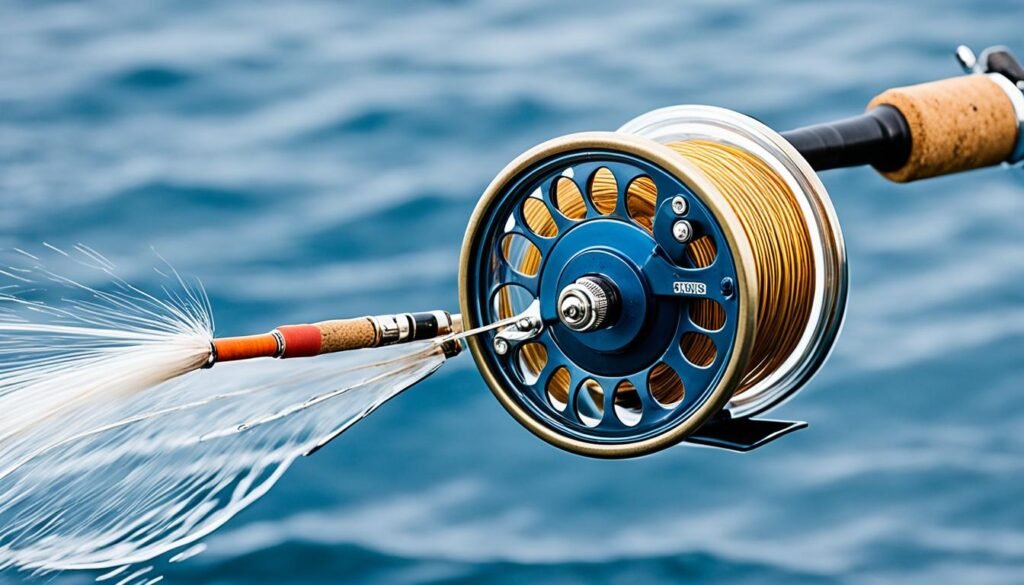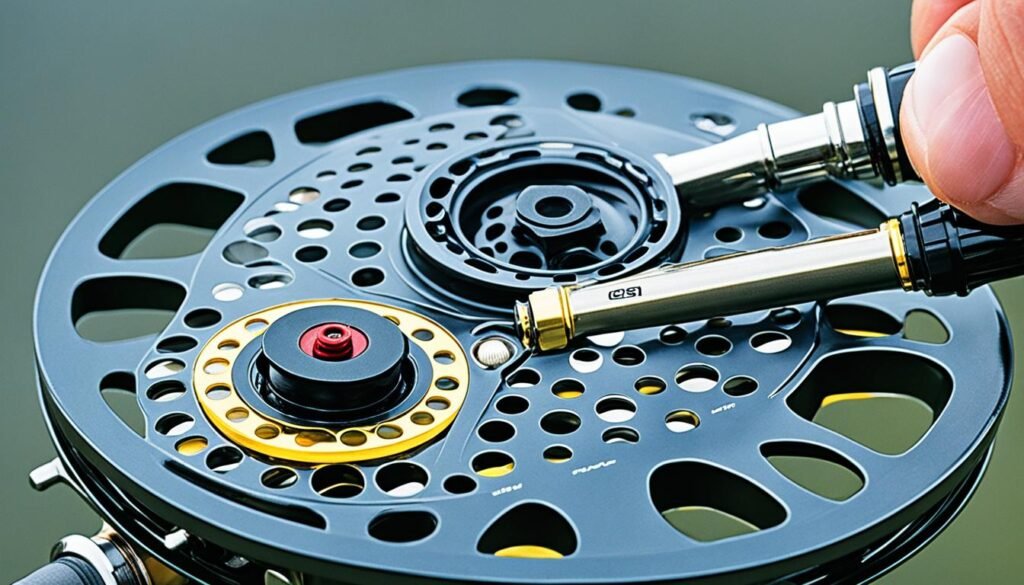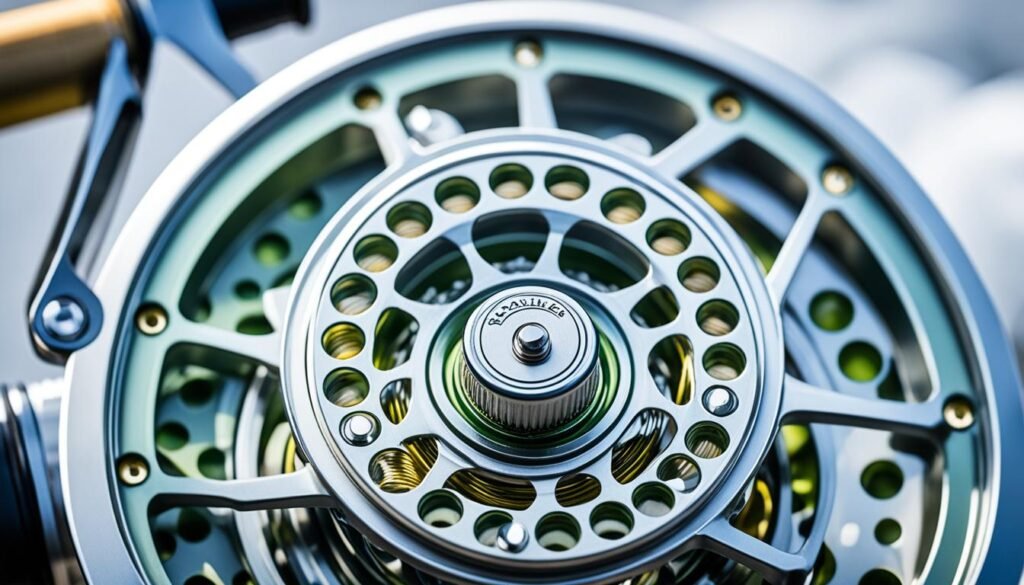Fly reel drag systems are an essential component of any fly fishing setup. To ensure optimal performance and longevity of your equipment, it is crucial to regularly maintain and properly lubricate the drag system. This article will provide you with essential tips and techniques for lubricating your fly reel drag system.
Key Takeaways:
- Regular maintenance and lubrication of fly reel drag systems are crucial for optimal performance.
- A well-lubricated drag system enhances smoothness, efficiency, and functionality.
- Understanding the type of drag system in your reel is important for proper maintenance and lubrication.
- Cork drag reels offer advantages such as tippet protection and lower start-up inertia.
- Sealed drag systems provide reliable and maintenance-free performance.
Types of Fly Reel Drag Systems
When it comes to fly reel drag systems, there are different types that anglers should be familiar with for proper maintenance and lubrication. The two main types of drag systems commonly found in fly reels are sealed disk drags and cork drags.
Sealed Disk Drags: Sealed disk drags are the most prevalent type of drag system used in fly reels. They utilize a stacked-washer design to create drag. Multiple washers, made of different materials, are compressed together to generate the desired resistance. This design allows for precise adjustment of the drag pressure. Sealed disk drags have gained popularity due to their reliability and smooth operation.
Cork Drags: Cork drag systems are typically found in draw-bar reels, which are commonly used for big-game fishing. These reels feature a larger, cylindrical design with a spool that slides back and forth on a draw-bar. The cork drag system consists of a series of cork discs that provide the necessary drag pressure. Cork drags offer a unique combination of smoothness and stopping power and are favored by anglers targeting large, hard-fighting fish.
Understanding the type of drag system in your fly reel is crucial for proper maintenance and lubrication. Different drag systems may require specific cleaning and lubrication techniques. By familiarizing yourself with the design and operation of your reel’s drag system, you can ensure that it performs optimally for your fishing adventures.
Comparing Sealed Disk Drags and Cork Drags
To further illustrate the differences between sealed disk drags and cork drags, here is a comparison table:
| Feature | Sealed Disk Drags | Cork Drags |
|---|---|---|
| Design | Stacked-washer | Cork discs |
| Adjustability | Precise adjustment | Varying drag settings |
| Smoothness | Consistently smooth | Smooth, with gradual increase in pressure |
| Stopping Power | Excellent | High, suited for big-game fishing |
| Resistance to Elements | Protected, minimal exposure | Minimal exposure, requires occasional maintenance |

Understanding the strengths and characteristics of each type of drag system will help you choose the reel that best suits your fishing style and target species. It is also important to ensure proper maintenance and lubrication of your reel’s drag system, regardless of the type, to ensure consistent performance and longevity.
Advantages of Cork Drag Reels
When it comes to fly fishing, cork drag reels offer several noteworthy advantages. Not only do they provide a smooth and reliable drag system, but they also excel in protecting light tippets, making them an excellent choice for anglers who prioritize delicate presentations. Let’s explore the key benefits of cork drag reels:
Protecting Tippet
The organic nature of cork, combined with its lateral flexibility, makes it ideal for protecting delicate tippets. When a fish makes a sudden run, cork drag reels exhibit lower start-up inertia, gradually building up drag pressure. This gradual increase in drag helps prevent excessive force on the tippet, reducing the risk of breakage and ensuring a successful catch.
Lateral Flexibility
Cork drag reels offer an inherent lateral flexibility that allows them to adapt to the sudden changes in a fish’s direction. This flexibility enhances the reel’s responsiveness when navigating the unpredictable movements of a powerful fish, ultimately improving the angler’s control over the fight.
The Rise of Synthetic Sealed Drags
While cork drag reels have long been favored by fly anglers, it’s worth noting that synthetic sealed drags have made significant advancements in terms of performance and durability. These modern drag systems can provide similar levels of smoothness and efficiency, making them a viable alternative to cork drag reels.
Ultimately, the choice between a cork drag reel and a synthetic sealed drag reel will depend on an angler’s personal preferences and fishing style. Both options offer distinct advantages and can deliver exceptional results on the water.
Now that we’ve explored the advantages of cork drag reels, let’s move on to discussing the importance of sealed drag systems and their benefits in the next section. But before we do, let’s take a moment to appreciate the beauty of a cork drag reel in action:

Importance of Sealed Drag Systems
Sealed drag systems, with their innovative stacked-washer design, offer significant advantages over other types of fly reel drag systems. These systems are fully protected from the elements, such as water and sand, ensuring reliable performance in any fishing conditions.
The stacked-washer design consists of a stack of small brake surfaces arranged in a horizontal column inside the large arbor of the reel. This design provides enhanced protection to the drag washers, preventing water and sand from penetrating the system and causing damage. Whether you’re fishing in freshwater or saltwater environments, a sealed drag system offers peace of mind, knowing that your reel is fully shielded from potential hazards.
Sealed drag systems are typically made of pancaked metal and Delrin, a slippery plastic material known for its durability and low friction coefficient. The combination of these materials ensures smooth and consistent drag performance throughout your fishing adventures. Since the reel is sealed, there is no need for additional lubrication once the drag system is properly maintained, simplifying your reel maintenance routine.
Benefits of Sealed Drag Systems:
- Enhanced protection: Fully protected from water and sand, preventing potential damage.
- Maintenance-free: No need for regular lubrication, reducing maintenance time and effort.
- Reliable performance: Offers smooth and consistent drag performance for a seamless fishing experience.
With a sealed drag system, you can focus on the thrill of the catch without worrying about the maintenance and performance of your reel. Invest in a fly reel with a sealed drag system, and enjoy the peace of mind it provides during your fishing adventures.

| Advantages of Sealed Drag Systems | Disadvantages of Unsealed Drag Systems |
|---|---|
|
|
Consequences of Unsealed Drag Failure
When it comes to fly reels, unsealed drag failure can have serious consequences. Without proper sealing, water and sand can infiltrate the drag surfaces, leading to potential reel failure.
Water is particularly problematic as it can cause the brake surfaces to hydroplane, resulting in reduced drag pressure. This compromised drag can make it difficult to control the line, which is essential when fighting a powerful fish. It can lead to backlash, tangled line, and ultimately, reel failure at a critical moment.
Sand, on the other hand, poses its own set of risks. Not only can it damage the drag surface, affecting its overall performance, but it can also impact other components of the reel. The spindle and locking gears, for instance, can be compromised, leading to further issues and potential reel failure.
To paint a clearer picture, here is a comparison table between sealed and unsealed drag systems:
| Consequences | Sealed Drag Systems | Unsealed Drag Systems |
|---|---|---|
| Water Damage | Minimal – Protected by seal | Substantial – Hydroplaning on brake surfaces |
| Sand Damage | Minimal – Protected by seal | Substantial – Damages drag surface, spindle, and locking gears |
| Reel Failure | Unlikely | Possible due to compromised drag and damaged components |
Above is a clear comparison between the consequences of a sealed drag system and an unsealed drag system. It highlights the potential risks of unsealed drag failure, emphasizing the importance of proper maintenance and sealing to protect your reel from these issues.
It’s crucial to remember that preventing water and sand damage is key to ensuring the longevity and functionality of your fly reel drag system.
Here’s an image illustrating the impact of water and sand damage on a reel:

Importance of Regular Maintenance
Regular maintenance of your fly reel, including lubrication of the drag system, is essential for its optimal performance. By prioritizing proper maintenance, you can ensure a smooth drag, sufficient backing capacity, and a reliable link between the angler and the fish.
A smooth drag system plays a crucial role when fighting larger fish. It provides the necessary resistance to tire out the fish, allowing you to maintain control throughout the fight. Whether you’re battling a feisty salmon or a powerful tarpon, a smooth drag system enhances your chances of a successful catch.
In addition to a smooth drag, regular maintenance ensures that your reel has sufficient backing capacity. Backing, a thin line attached to the fly line, serves as extra insurance when a fish takes long, powerful runs. Neglecting maintenance can compromise the backing’s functionality, potentially leading to line breakage and lost fish.
Moreover, proper maintenance establishes a reliable link between the angler and the fish. Imagine the disappointment of losing a trophy catch due to equipment failure. By regularly lubricating your drag system, you reduce the risk of malfunctions and increase the overall reliability of your reel.
Don’t let negligence hamper your fishing experience. Take the time to maintain your fly reel and enjoy the benefits of a smooth drag, ample backing capacity, and a reliable connection between you and the fish.

Tips for Maintaining Fly Fishing Reels
Fly fishing reels require regular maintenance to ensure long-lasting performance and optimal functionality. By taking proper care of your reel, you can extend its lifespan and enjoy smooth and reliable operation during your fishing adventures. Here are some essential tips for maintaining your fly fishing reels:
1. Protect Frame and Spool Material
In saltwater fly fishing, it’s crucial to protect the frame and spool material from corrosion and rust. After each use, rinse your reel thoroughly with freshwater to remove any salt residue or debris. Dry the reel completely before storing it to prevent the formation of rust. Additionally, consider applying a corrosion-resistant coating or reel case to provide extra protection.
2. Clean and Lubricate the Drag Mechanism
The drag mechanism is a vital component of any fly reel, whether it’s a disc drag or click-and-pawl drag. Regularly clean the drag system to remove any dirt, sand, or debris that may accumulate over time. Use a soft cloth or brush to gently wipe the drag surfaces, ensuring that no abrasive particles remain. Once cleaned, apply a small amount of reel lubricant specifically designed for drag systems to ensure smooth operation.
3. Lubricate Other Moving Parts
In addition to the drag mechanism, it’s important to lubricate other moving parts of your reel. The handle, spool release mechanism, and any exposed bearings may require periodic lubrication to maintain their smooth operation. Refer to the manufacturer’s instructions or consult a professional to determine the appropriate lubricant for your reel’s specific components.
4. Choose Saltwater Fly Fishing Reels Wisely
If you frequently fish in saltwater environments, consider investing in a reel specifically designed for such conditions. Saltwater fly fishing reels are typically constructed with corrosion-resistant materials, such as stainless steel or anodized aluminum, to withstand the harsh effects of saltwater. These reels often feature sealed drag systems and additional protective coatings to provide enhanced durability and longevity.
5. Store Reels Properly
When not in use, store your fly fishing reels in a dry and well-ventilated area. Avoid exposing them to extreme temperatures or direct sunlight, as these can negatively impact their performance and integrity. Consider using reel cases or pouches to provide additional protection during storage and transportation.
Proper maintenance and care of your fly fishing reels will not only ensure their longevity but also enhance your overall fishing experience. By following these tips, you can keep your reels in top-notch condition and enjoy many successful fishing trips.

Proper Cleaning and Storage
After each fishing excursion, it is crucial to take proper care of your fly reel to ensure its longevity and performance. Cleaning and storing your reel correctly will help protect it from corrosion and damage caused by contaminants. Follow these steps for proper cleaning and storage of your fly reel:
- Rinse with Freshwater: Start by rinsing your reel with freshwater to remove any dirt, sand, or saltwater residue that may have accumulated. Using a gentle stream of water, carefully rinse all parts of the reel, including the drag system, spool, and frame. This will help prevent any grit from causing damage to the reel’s internal components. Avoid using high-pressure water as it can force dirt deeper into the reel.
- Avoid Pressure Washing: Many anglers may be tempted to use a pressure washer to clean their reels quickly. However, this can be detrimental to the reel’s delicate components. The high-pressure water can damage the drag system, seals, and other critical parts. Stick to the gentle rinsing method mentioned above to maintain the integrity of your reel.
- Deep Cleaning: Periodically, it is essential to give your reel a deep cleaning to remove any stubborn grime or debris that may have accumulated over time. This is especially crucial if you frequently fish in harsh conditions or saltwater environments. Consult the manufacturer’s instructions or seek professional guidance on the recommended deep cleaning process for your specific reel model.
- Bone Dry Storage: Before storing your reel, ensure that it is completely dry to prevent corrosion. Use a soft towel or cloth to gently remove any excess moisture from the reel’s exterior. Then, allow the reel to air dry in a well-ventilated area. It is also advisable to store the reel in a bone dry environment, away from any sources of moisture or humidity. This will help maintain the reel’s performance and longevity.
Proper cleaning and storage practices are essential for maximizing the lifespan and performance of your fly reel. By following these steps, you can ensure that your reel stays in optimal condition and ready for your next fishing adventure.

Switching Retrieve Directions
If you need to switch the retrieve direction of your fly reel, there are specific steps to follow. Properly adjusting the retrieve direction is essential for a smooth fishing experience. Here’s a guide to help you navigate the process:
Spool Removal
For some fly reel models, spool removal is necessary to switch the retrieve direction. Begin by locating the spool release mechanism, usually found on the side of the reel. Follow the manufacturer’s instructions to release the spool and remove it from the reel body. Take care not to lose any small parts during this process.
Hub Removal
In certain fly reel designs, hub removal is required to switch the retrieve direction. Look for a locking mechanism on the reel hub, such as a screw or lever. Follow the manufacturer’s instructions to unlock and remove the hub from the reel. Be mindful of any additional components and keep them in a safe place.
Clicker Removal
In some cases, the clicker assembly may need to be removed to switch the retrieve direction. Check if your fly reel has a clicker mechanism, typically located near the drag system. Consult the manufacturer’s instructions to disengage and remove the clicker assembly carefully. Keep track of any screws or small parts during this process.
Adjusting the Pawl Position
Once the necessary parts are removed or disengaged, adjusting the pawl position is crucial for proper retrieve direction. The pawl is responsible for engaging with the reel’s gear teeth, determining the direction the handle turns. Follow the manufacturer’s instructions or consult a professional to ensure you adjust the pawl correctly based on your fly reel model.
Note: It is important to follow the manufacturer’s instructions for your specific fly reel model when switching the retrieve direction. Seek professional guidance if you are unsure about the process or prefer expert assistance.

| Component | Steps |
|---|---|
| Spool Removal | 1. Locate the spool release mechanism 2. Follow manufacturer’s instructions to release and remove the spool Note: Be careful not to lose any small parts |
| Hub Removal | 1. Identify the locking mechanism on the reel hub 2. Follow manufacturer’s instructions to unlock and remove the hub Note: Store any additional components in a safe place |
| Clicker Removal | 1. Check if your fly reel has a clicker mechanism 2. Consult manufacturer’s instructions to disengage and remove the clicker assembly Note: Keep track of screws and small parts |
| Adjusting the Pawl Position | 1. Follow manufacturer’s instructions to adjust the pawl position 2. Ensure the pawl engages with the reel’s gear teeth correctly |
By following these steps and consulting the manufacturer’s instructions or seeking professional guidance, you can successfully switch the retrieve direction of your fly reel.
Conclusion
Proper maintenance and lubrication of fly reel drag systems are vital for ensuring the optimal performance and longevity of your equipment. By regularly cleaning, rinsing, and lubricating your drag system, you can enhance its smoothness and efficiency, providing a reliable connection between you and the fish.
Remember to follow the tips and techniques outlined in this article to maintain your fly reel drag system effectively. Whether it’s lubricating the drag washers, cleaning the frame and spool, or properly storing your reel, these maintenance practices will ensure smooth operation on your next fishing adventure.
Investing time in fly reel maintenance not only enhances its performance but also protects your investment. A well-maintained drag system will provide consistent and reliable resistance, enabling you to successfully land and control fish in various angling situations. So, keep those reels clean, lubricated, and ready for action!
FAQ
Why is regular maintenance and lubrication important for fly reel drag systems?
Regular maintenance and lubrication ensure optimal performance, enhancing the smoothness, efficiency, and functionality of the drag system.
What are the different types of fly reel drag systems?
Fly reel drag systems can include sealed disk drags and cork drags. Sealed disk drags are more common and use stacked washers, while cork drags are typically found in draw-bar reels.
What are the advantages of cork drag reels?
Cork drag reels have lower start-up inertia, protecting light tippets and line-class records. Their organic nature and lateral flexibility contribute to their performance. However, sealed drags have become equivalent in terms of performance and durability.
Why are sealed drag systems important?
Sealed drag systems, with their stacked-washer design, protect the drag washers from water and sand, providing reliable and maintenance-free performance. They often use pancaked metal and Delrin, which do not require additional lubrication once sealed.
What are the consequences of unsealed drag failure?
Water or sand damage can cause drag failure in unsealed reels, leading to reduced drag pressure, potential reel failure, backlash, tangled line, and other problems during a fish fight.
Why is regular maintenance important for fly fishing reels?
Regular maintenance, including lubrication of the drag system, ensures optimal reel performance, including smooth drag operation, sufficient backing capacity, and a reliable link between the angler and the fish.
What areas of a fly reel require maintenance?
Fly reel maintenance includes protecting the frame and spool material from corrosion and rust, regular cleaning and lubrication of the drag mechanism, and periodic lubrication of other moving parts, such as the handle.
How should I clean and store my fly reel?
After each use, rinse the reel with freshwater to remove grit or contaminants. Avoid high-pressure water. Periodically perform deep cleaning, especially after fishing in harsh conditions or saltwater. Ensure the reel is completely dry before storage and consider lubricating it annually.
How do I switch the retrieve direction of my fly reel?
The specific steps to switch the retrieve direction vary depending on the reel. Some may require spool or hub removal, and the clicker assembly may need to be removed as well. Adjusting the pawl position is crucial for the proper retrieve direction.
Why is proper maintenance and lubrication important for fly reel drag systems?
Proper maintenance and lubrication are essential for optimal performance and longevity of the equipment. Regular cleaning, rinsing, and lubrication enhance the smoothness and efficiency of the drag, providing a reliable link between the angler and the fish.

